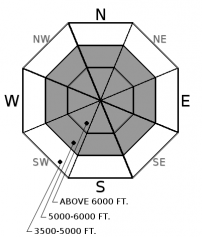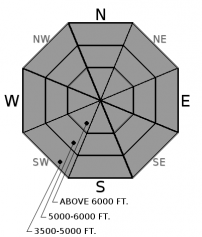| Thursday | Thursday Night | Friday | |
|---|---|---|---|
| Cloud Cover: | Rain and snow mix | Rain/snow mix transitioning to mostly snow | Light rain and snow mix |
| Temperatures: | 35 to 45 deg. F. | 23 to 31 deg. F. | 32 to 40 deg. F. |
| Wind Direction: | Southwest | Southwest | Southwest |
| Wind Speed: | 12-15 with gusts to 32 mph | 12-14 with gusts to 29 mph | 9-13 with gusts to 28 mph |
| Snowfall: | 0-2 in. | 0-2 in. | 1-2 in. |
| Snow Line: |
Swan Range
Flathead Range and Glacier National Park
How to read the forecast
The avalanche danger is MODERATE at all elevations today. Tropical moisture in the form of rain has entered the area. The snow surface is already saturated in places due to 48 hours of above freezing temperatures at mid and upper elevations. The strong rain crust is breaking down in places and it is possible to have wet loose avalanches or trigger an avalanche on an older persistent weak layer or wind loaded slope.

2. Moderate
?
Above 6500 ft.
2. Moderate
?
5000-6500 ft.
2. Moderate
?
3500-5000 ft.
- 1. Low
- 2. Moderate
- 3. Considerable
- 4. High
- 5. Extreme
-
Type ?
-
Aspect/Elevation ?

-
Likelihood ?CertainVery LikelyLikelyPossible
 Unlikely
Unlikely -
Size ?HistoricVery LargeLargeSmall

In places, stability tests are still showing reactive results around the January 19 crust and, in isolated locations, the depth hoar at the bottom of the pack is still a concern. The warmer temperatures the last couple of days and rain/snow we are receiving and forecasted to receive will increase instability. These weak layers do not always present obvious signs of instability and digging into the snowpack is the best way to determine their location and reactivity. Be cautious in locations where the surface crust is weaker/softer or non-existent.
-
Type ?
-
Aspect/Elevation ?

-
Likelihood ?CertainVery LikelyLikelyPossible
 Unlikely
Unlikely -
Size ?HistoricVery LargeLargeSmall

Temperatures have been above freezing for over 48 hours in some locations and additional rain this morning means even more stress on the snowpack and continuing break down of the surface structure. The rain crust from last week is strong in places, but in other areas we have found it to be weaker and decomposing, making loose wet avalanches more likely. Look for signs of instability associated with loose wet avalanches that include rollerballs, tree bombs, and recent wet loose sluffs on steep slopes, especially near rocks and trees.
Tropical moisture has entered the area bringing continued warm temperatures and some rain. The rain crust is the key to stability right now. Where it is present, it will improve stability. Where it isn't present or is breaking down you could find instabilities associated with wind slabs, weaker layers deeper in the snowpack and or loose snow avalanches. Because of the widespread rain crust, and the fact it reached to higher elevations, there is little snow available for transport by the wind. Recent observations have shown that the rain crust in the Whitefish Range may be weaker and more variable than it is in other ranges, which may increase the instability. Be cautious in areas where there is no rain crust and that show signs of wind slab development. The widespread rain crust will help keep the snow in place, but wet loose avalanches and cornice failures could become a concern in some locations.
Ladies, are you interested in refreshing your avalanche knowledge or looking for a great introduction to avalanche safety? If so, join us at The White Room Mountain Shop, in Whitefish tonight, Thursday, February 16th at 6:30 pm for a free, engaging, and entertaining 1 hour avalanche awareness presentation. The class includes general information about avalanche hazard, how to avoid it, and proper equipment for traveling in avalanche terrain.
We would like to thank all those who have been submitting observations recently. These observations are invaluable and improve our forecasts. Several observers have submitted reports from across the advisory area documenting the widespread avalanche activity from last week (see our Observations Page). Thank you!
Wednesday: Guy and Seth travelled to Red Meadow Lake in the Northern Swan Range where they found temperatures above freezing, variable surface snow conditions and evidence of natural avalanche cycle from the Frebruary 3-10 cycle. At least one of those avalanches ran on the January 19 crust (Avalanche Observation). We also received a public observation from Werner Peak that affirmed there is still instability associated with the January 19 crust (Snowpack Observation).
Tuesday: Seth and Adam were in Noisy Basin where they also observed widespread avalanche activity from the February 3-10 natural cycle (Avalanche Observation). They also found a strong and supportable rain crust to over 7000 feet. They found the January 19 crust and associated weak layer above, but it was stubborn to fail and they did not get propagation. Aspects exposed to the sun were definitely impacted, but it was not enough to break down the strong crust at the surface. Other observations from the Swan Face did report some point releases and roller balls caused by the sun and warming temperatures.
See below for all observations this season.
In the past 24 hours, temperatures ranged from the low thirties to 46ºF with winds out of the southwest that averaged 6-25 mph with maximum gusts of 14-53 mph. Today tropical moisture has entered the area and we should see a rain/snow mix with moderate Southwest winds and temperatures reaching the upper 30s to low 40s.
| 0600 temperature: | 31 to 39 deg. F. |
| Max. temperature in the last 24 hours: | 32 to 46 deg. F. |
| Average wind direction during the last 24 hours: | Southwest |
| Average wind speed during the last 24 hours: | 6-25 mph |
| Maximum wind gust in the last 24 hours: | 14-53 mph |
| New snowfall in the last 24 hours: | 0 inches |
| Total snow depth: | 70-97 inches |
This advisory applies only to backcountry areas outside established ski area boundaries. This advisory describes general avalanche conditions and local variations always occur. This advisory expires at midnight on the posted day unless otherwise noted. The information in this advisory is provided by the USDA Forest Service who is solely responsible for its content.



























